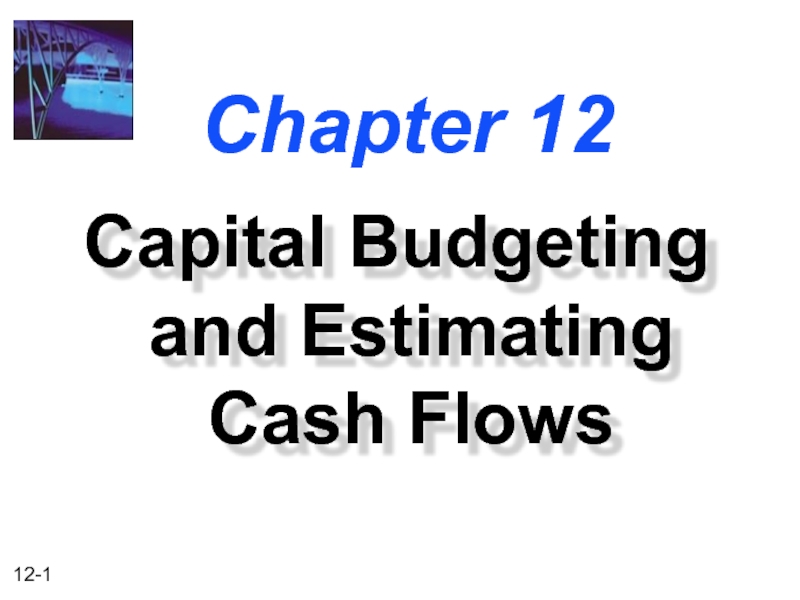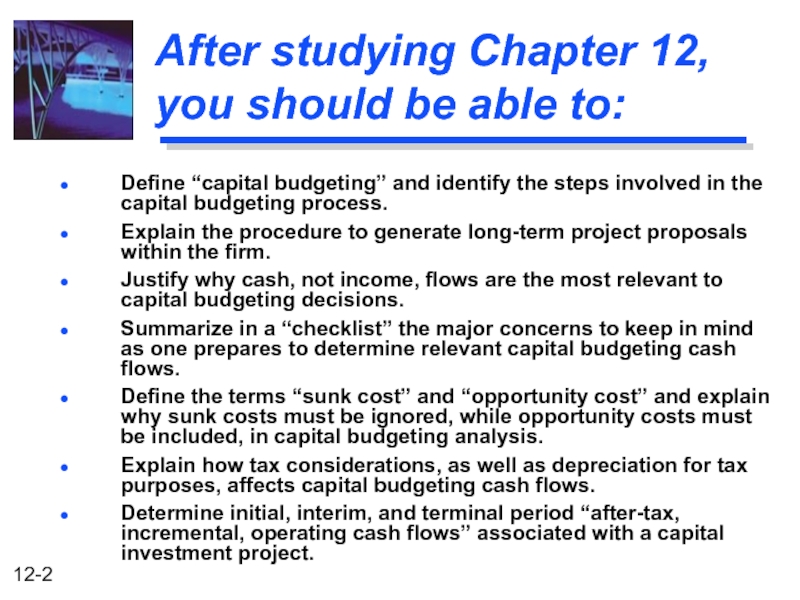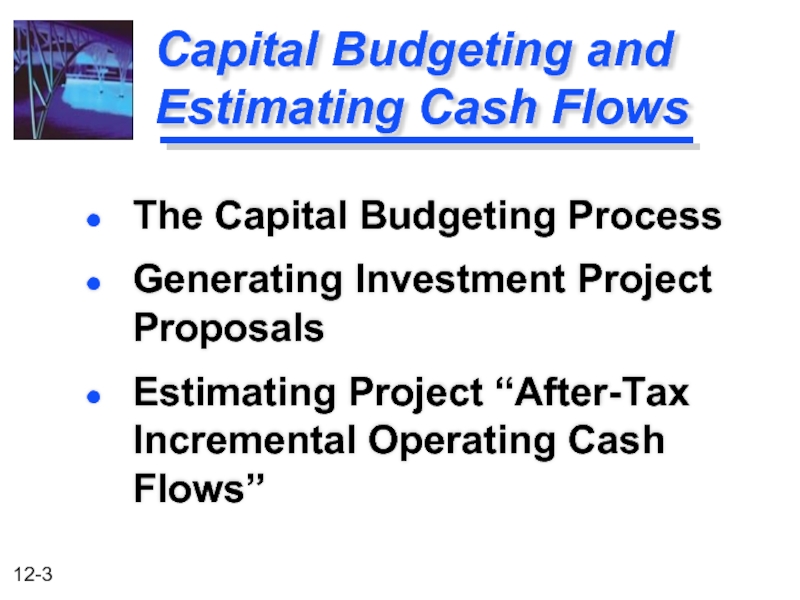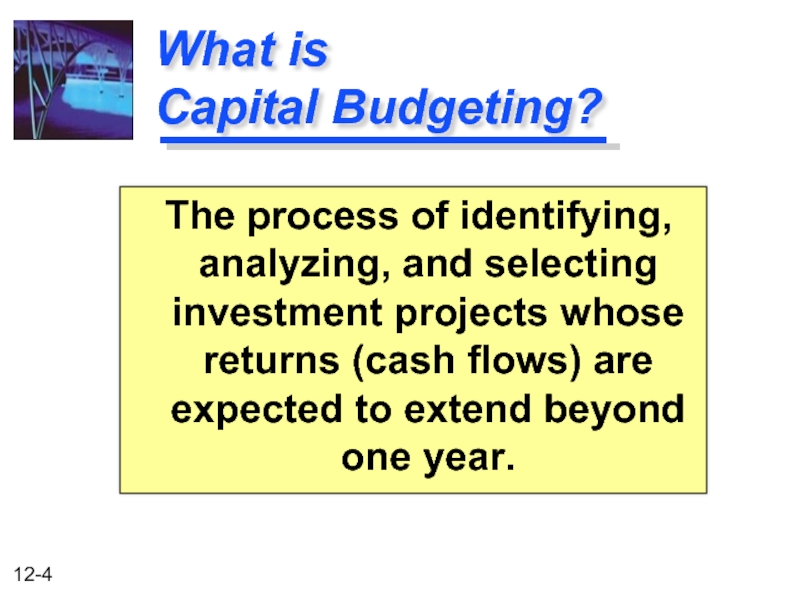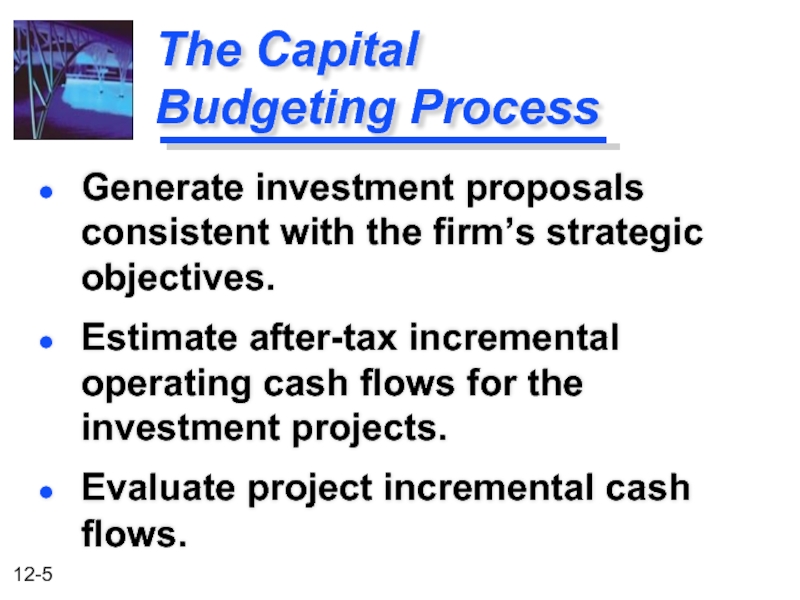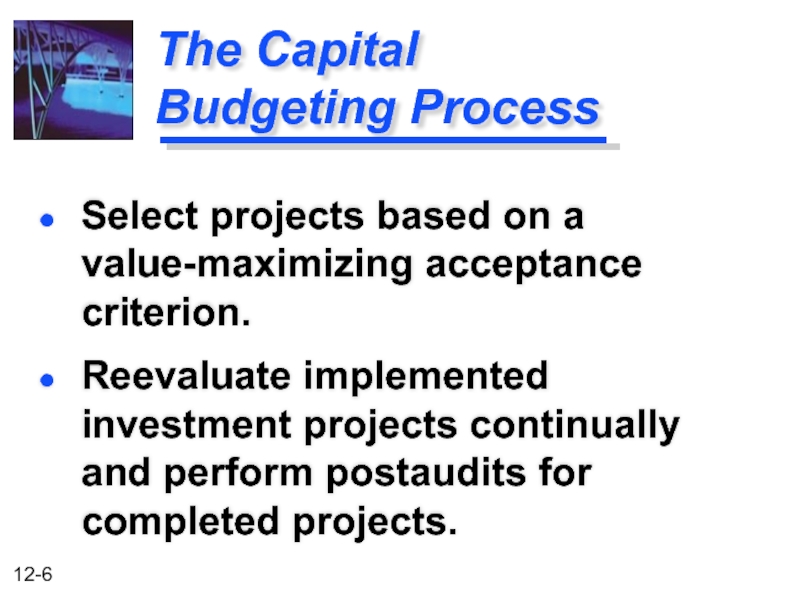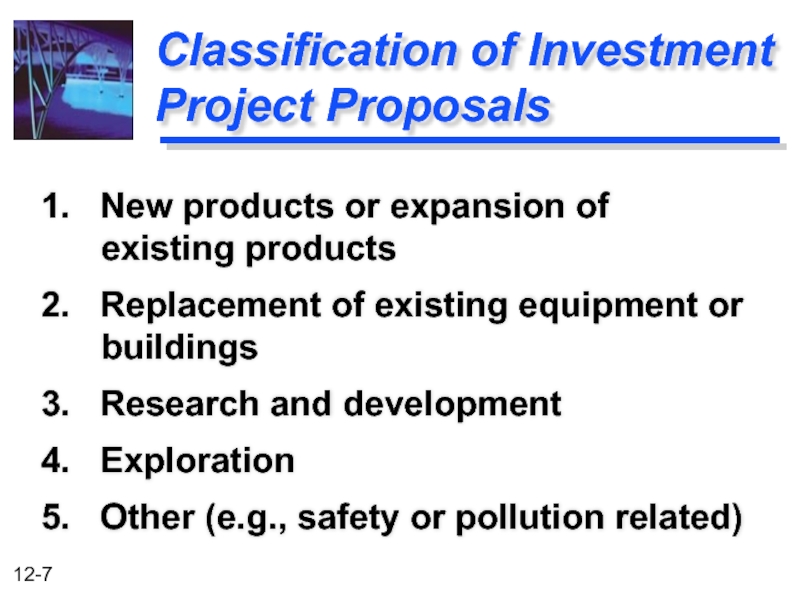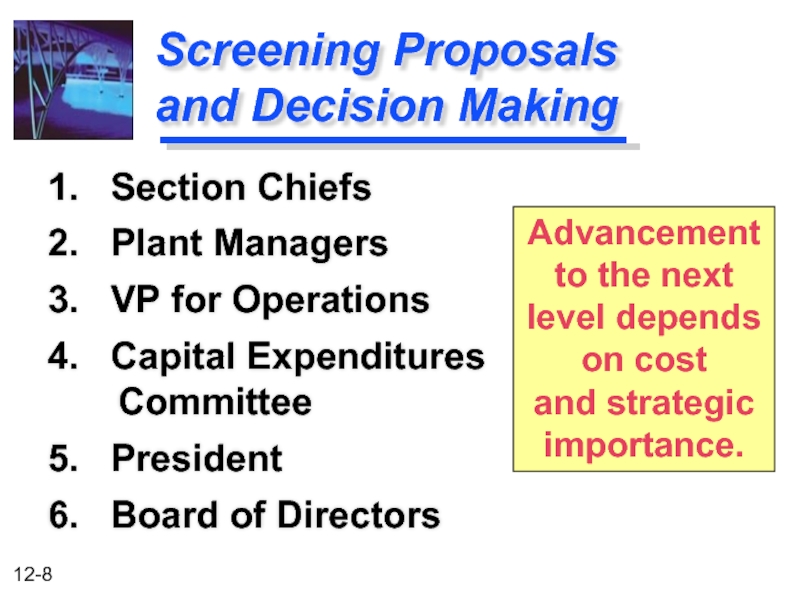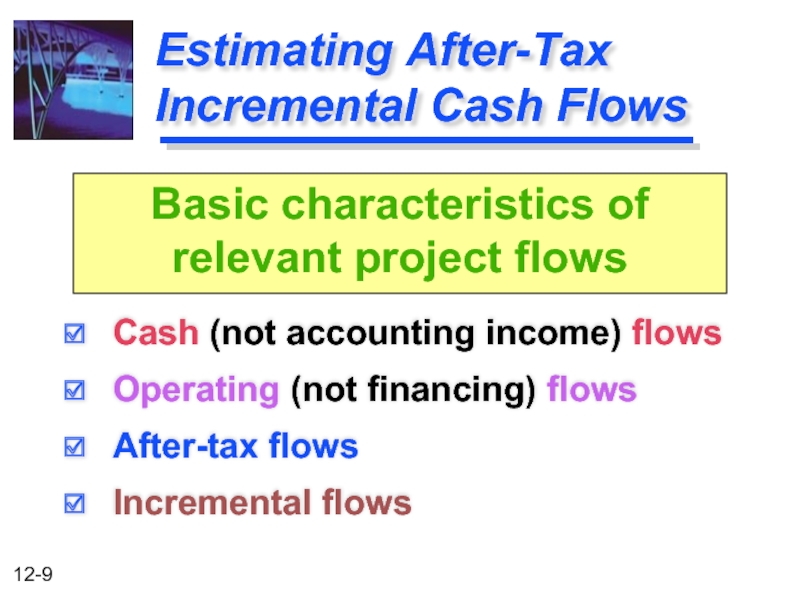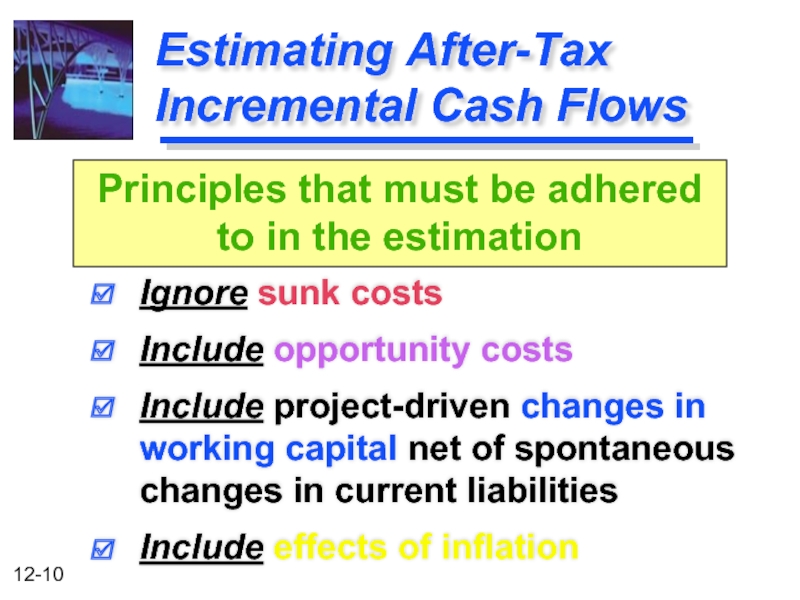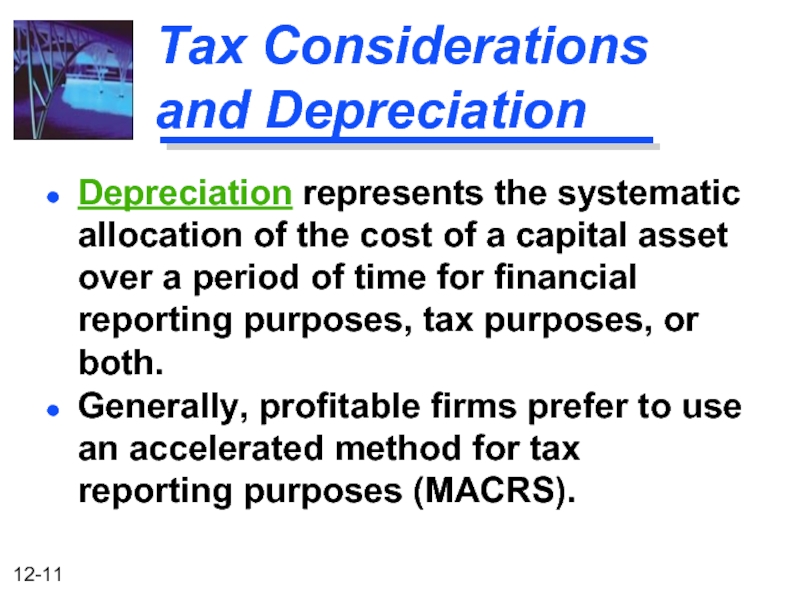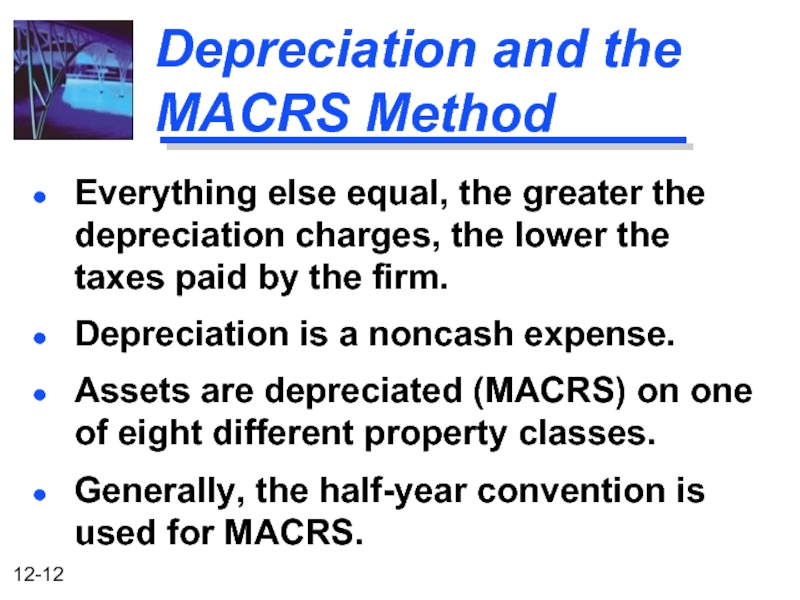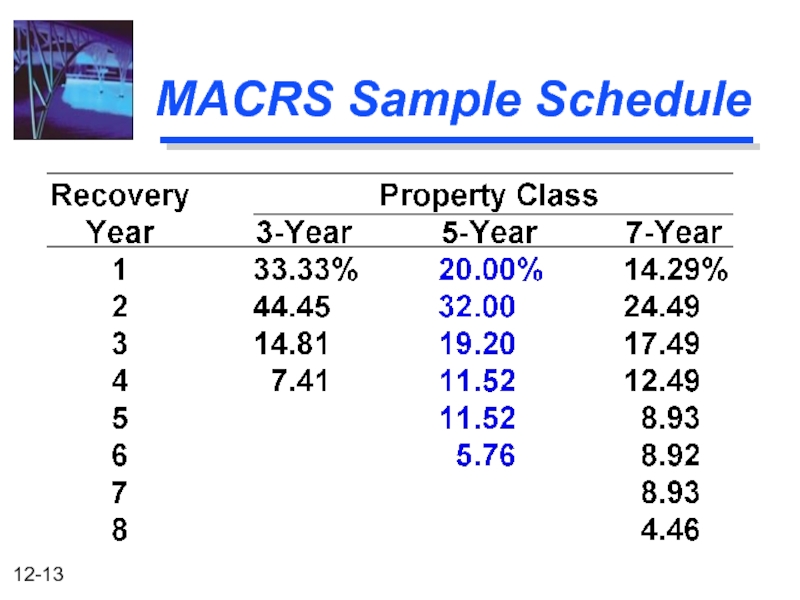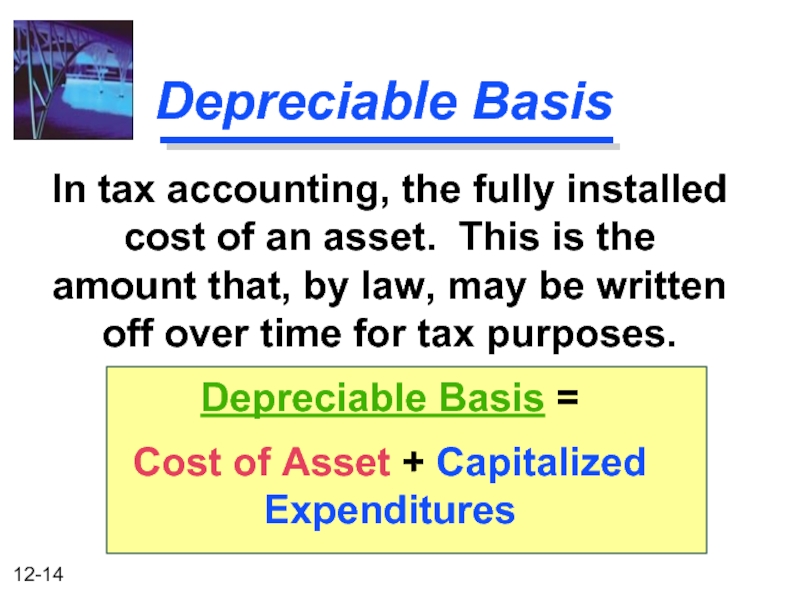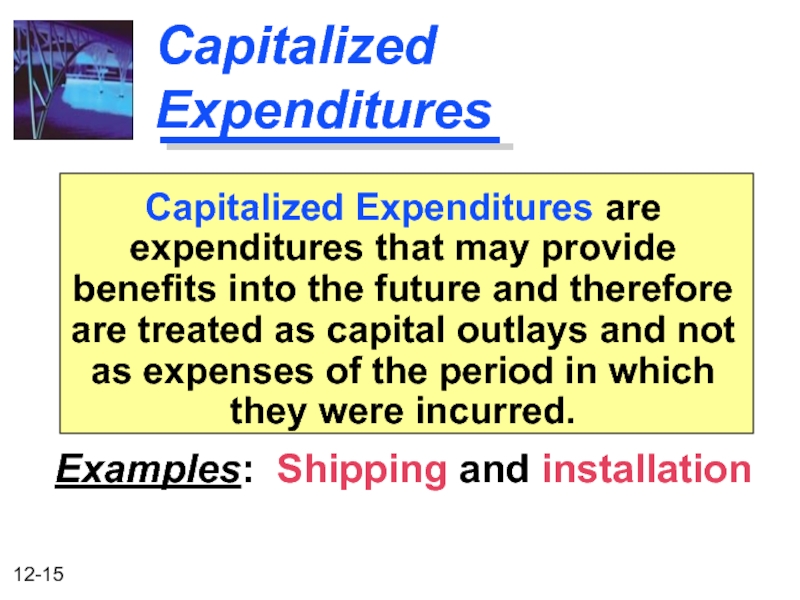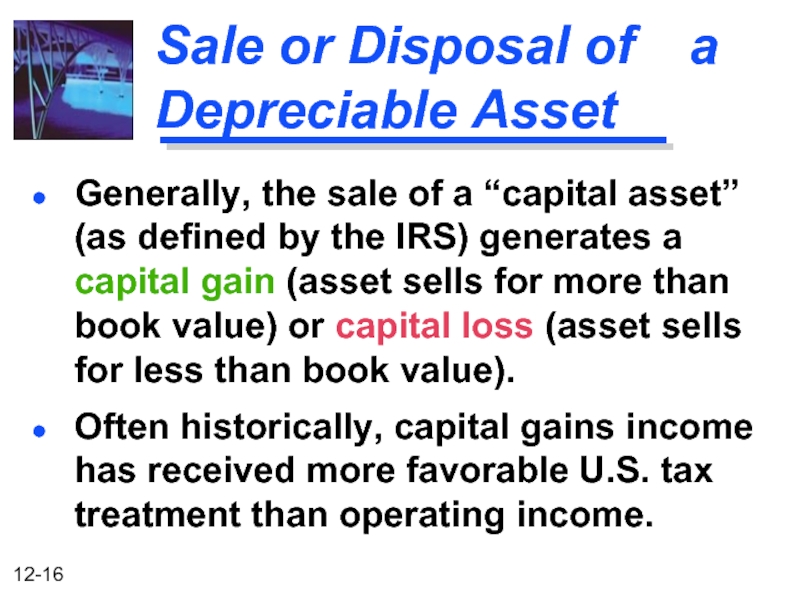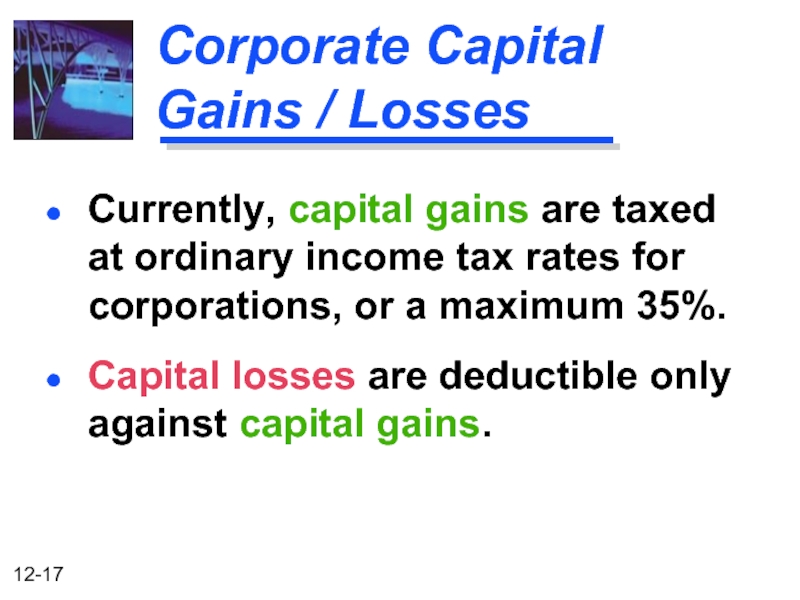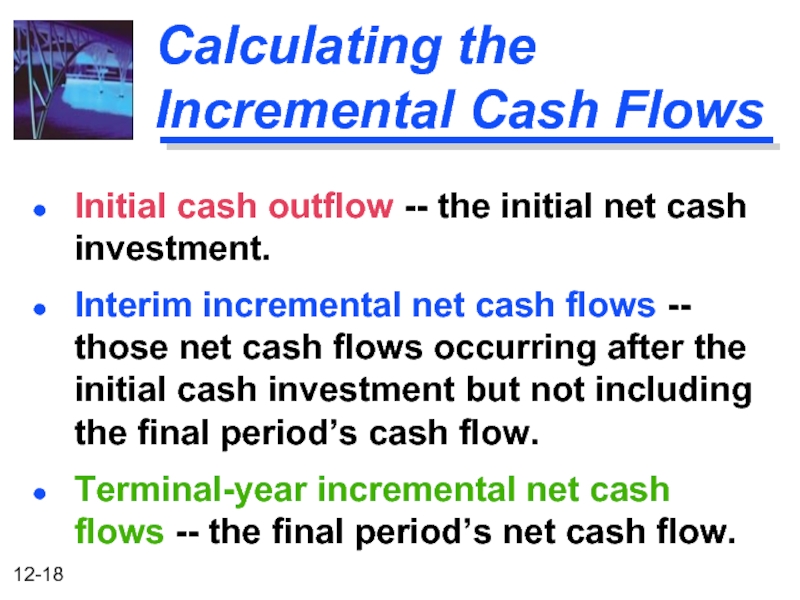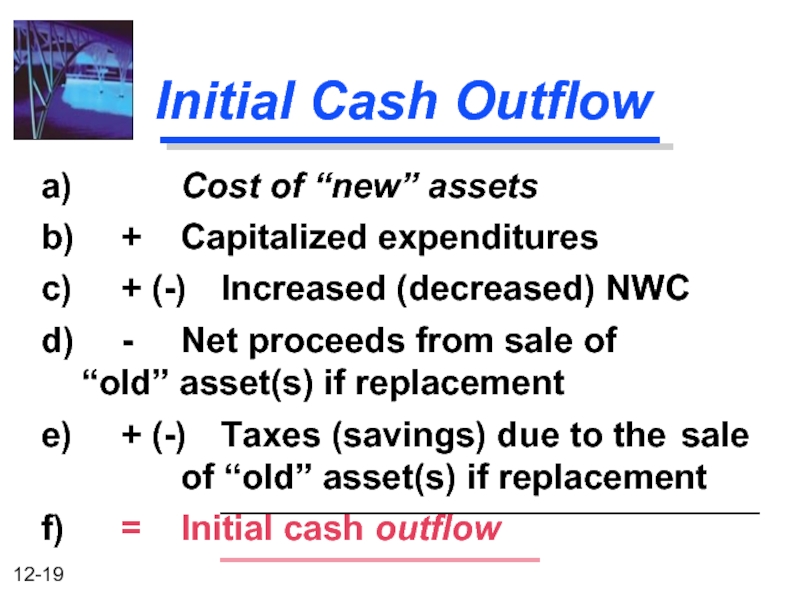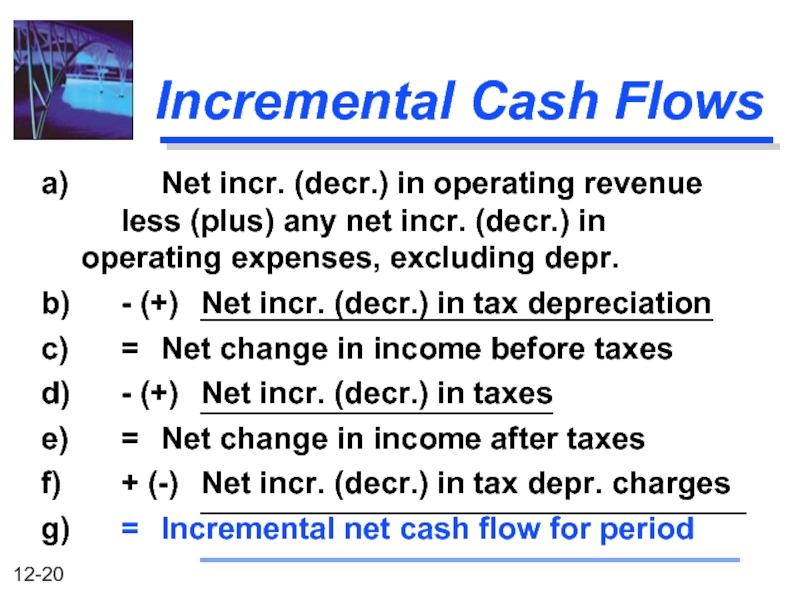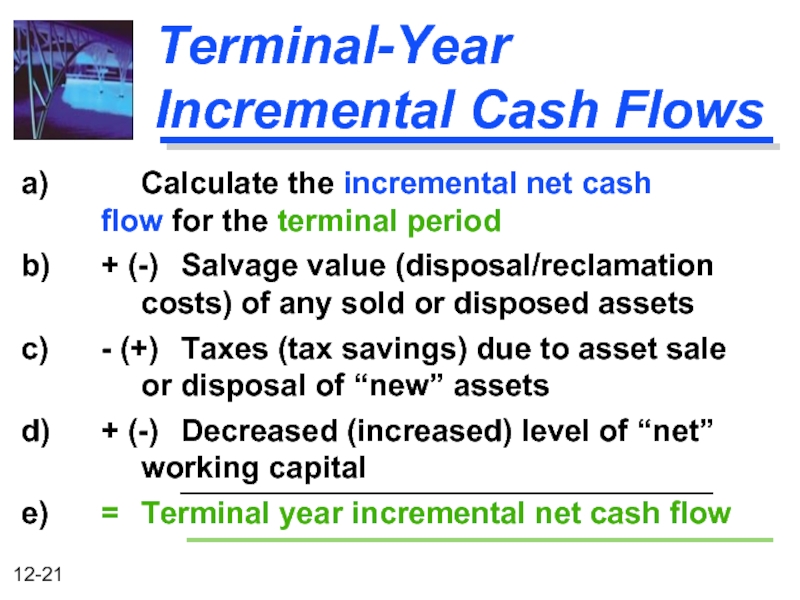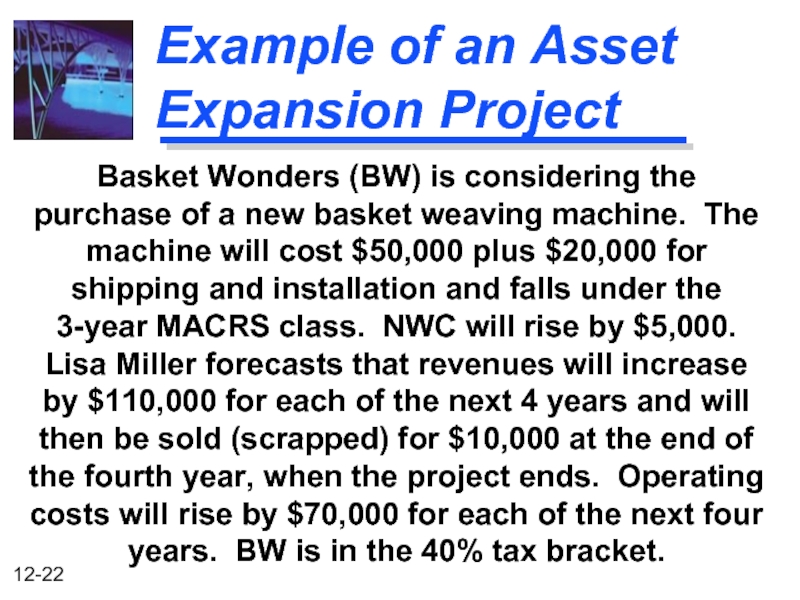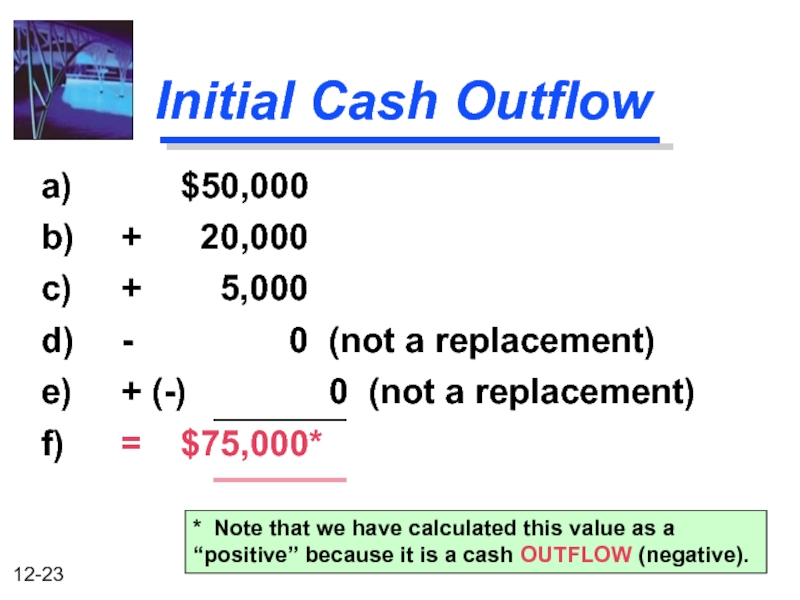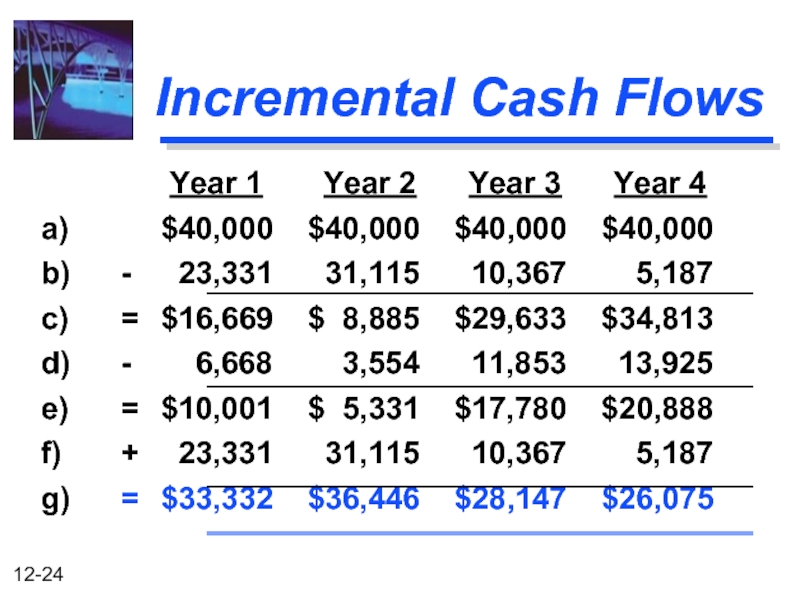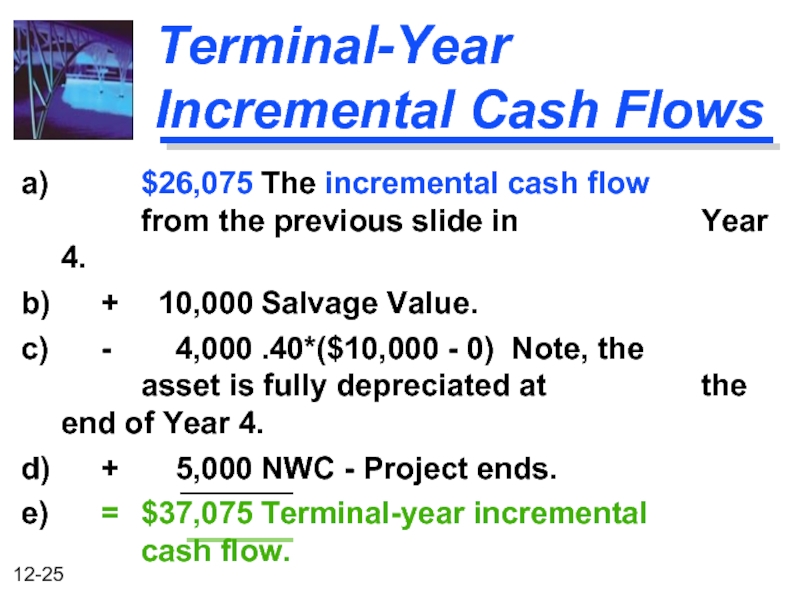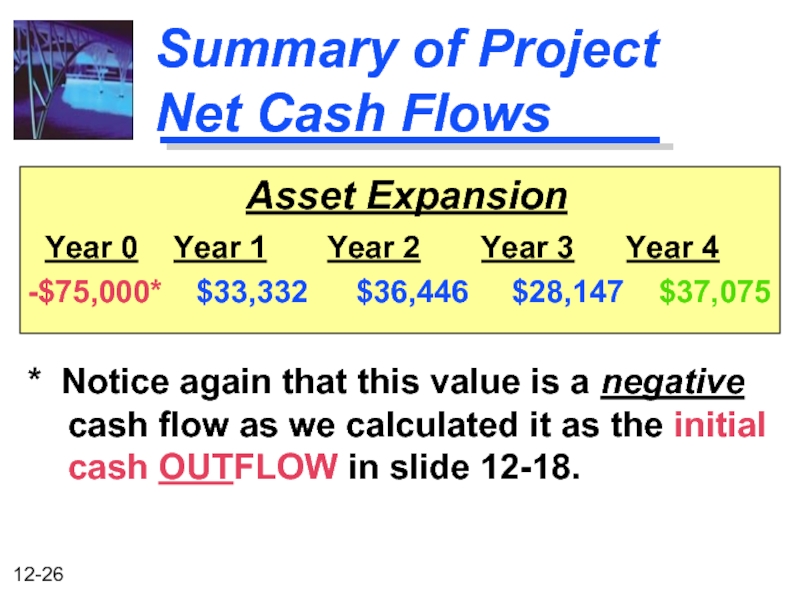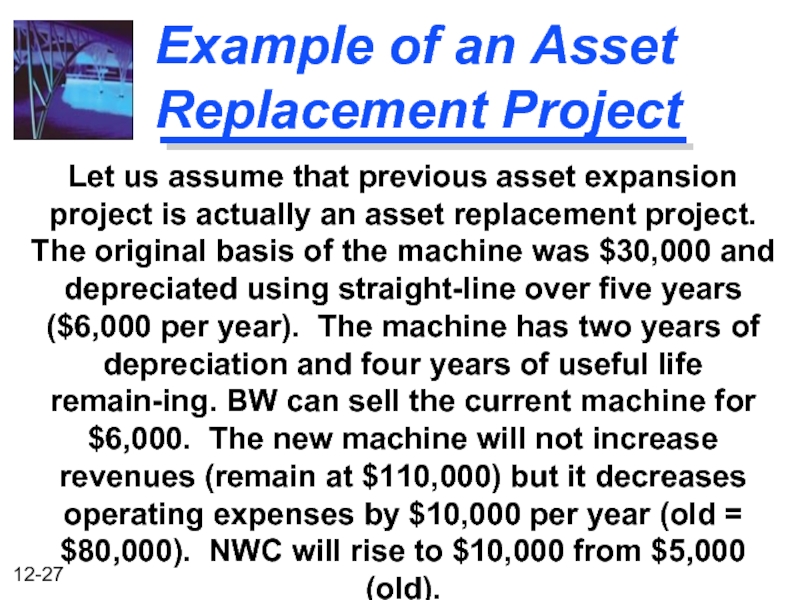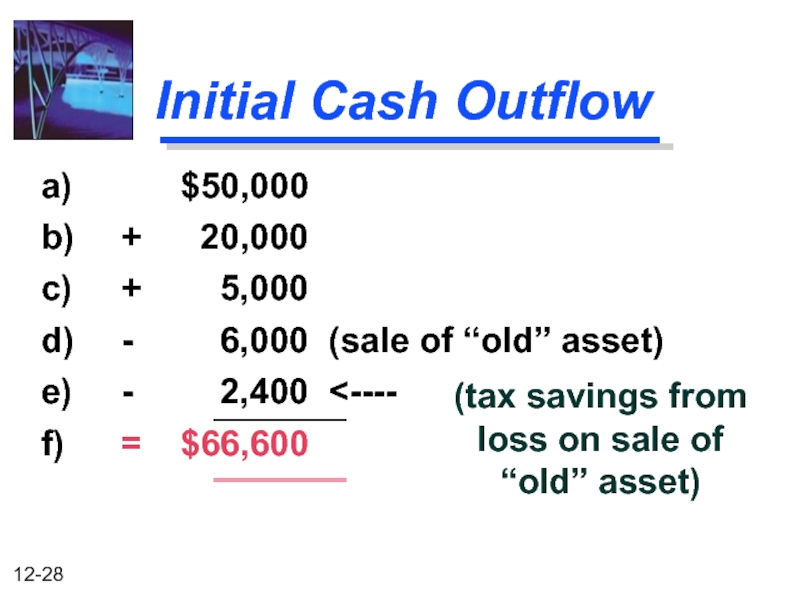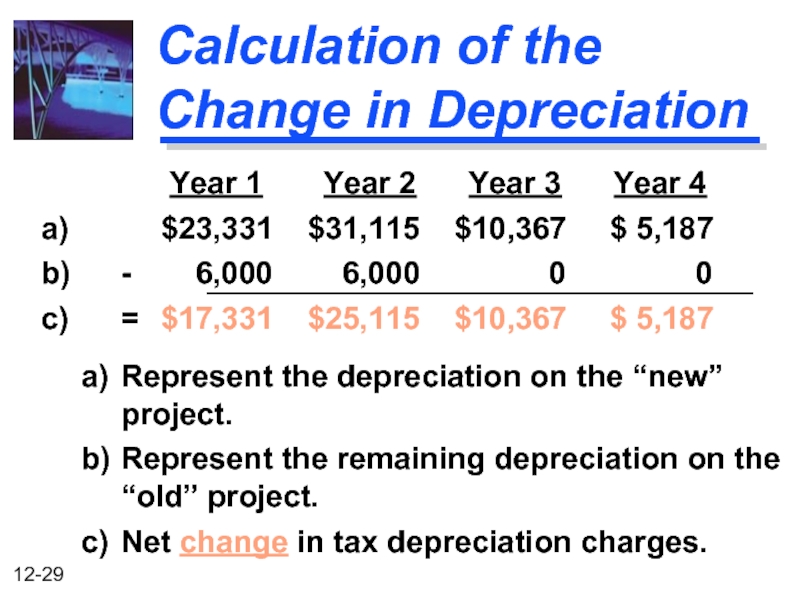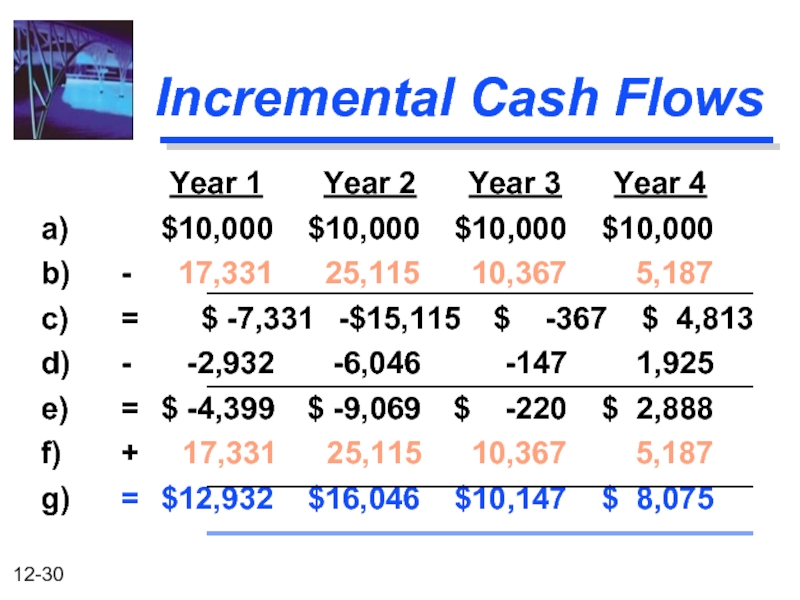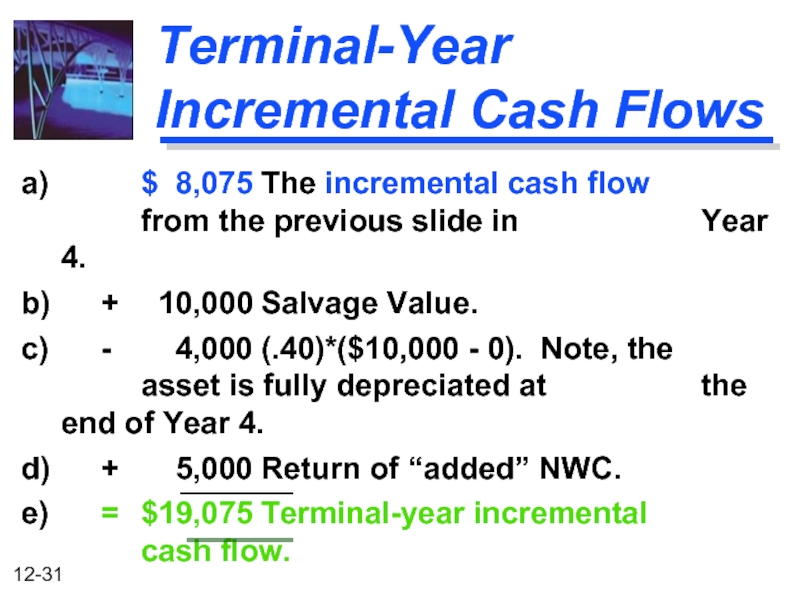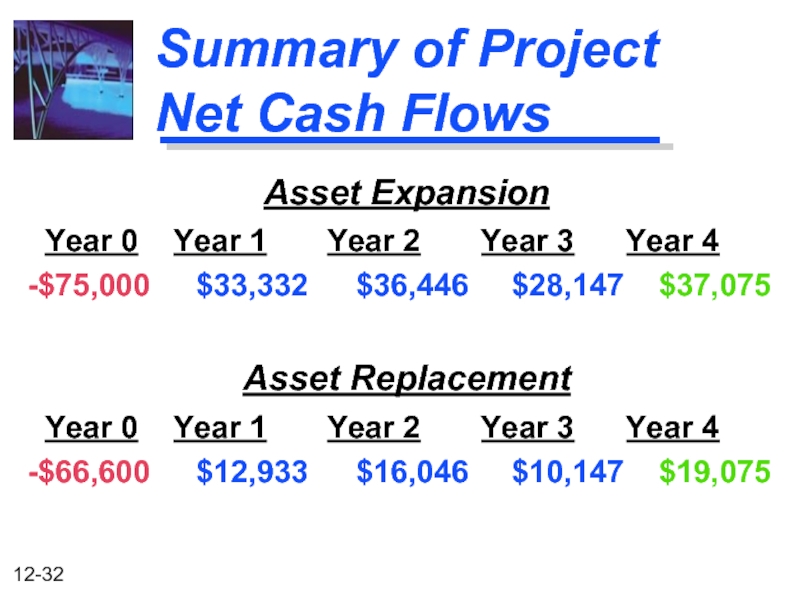- Главная
- Разное
- Дизайн
- Бизнес и предпринимательство
- Аналитика
- Образование
- Развлечения
- Красота и здоровье
- Финансы
- Государство
- Путешествия
- Спорт
- Недвижимость
- Армия
- Графика
- Культурология
- Еда и кулинария
- Лингвистика
- Английский язык
- Астрономия
- Алгебра
- Биология
- География
- Детские презентации
- Информатика
- История
- Литература
- Маркетинг
- Математика
- Медицина
- Менеджмент
- Музыка
- МХК
- Немецкий язык
- ОБЖ
- Обществознание
- Окружающий мир
- Педагогика
- Русский язык
- Технология
- Физика
- Философия
- Химия
- Шаблоны, картинки для презентаций
- Экология
- Экономика
- Юриспруденция
Capital Budgeting and Estimating Cash Flows презентация
Содержание
- 1. Capital Budgeting and Estimating Cash Flows
- 2. After studying Chapter 12, you should be
- 3. Capital Budgeting and Estimating Cash Flows The
- 4. What is Capital Budgeting? The
- 5. The Capital Budgeting Process Generate investment proposals
- 6. The Capital Budgeting Process Select projects based
- 7. Classification of Investment Project Proposals 1.
- 8. Screening Proposals and Decision Making 1.
- 9. Estimating After-Tax Incremental Cash Flows Cash (not
- 10. Estimating After-Tax Incremental Cash Flows Ignore sunk
- 11. Tax Considerations and Depreciation Generally, profitable firms
- 12. Depreciation and the MACRS Method Everything else
- 13. MACRS Sample Schedule
- 14. Depreciable Basis In tax accounting, the
- 15. Capitalized Expenditures Capitalized Expenditures are expenditures
- 16. Sale or Disposal of a Depreciable
- 17. Corporate Capital Gains / Losses Capital losses
- 18. Calculating the Incremental Cash Flows Initial cash
- 19. Initial Cash Outflow a) Cost of “new”
- 20. Incremental Cash Flows a) Net incr. (decr.) in
- 21. Terminal-Year Incremental Cash Flows a) Calculate the
- 22. Example of an Asset Expansion Project Basket
- 23. Initial Cash Outflow a) $50,000 b) +
- 24. Incremental Cash Flows Year 1
- 25. Terminal-Year Incremental Cash Flows a) $26,075 The incremental
- 26. Summary of Project Net Cash Flows
- 27. Example of an Asset Replacement Project Let
- 28. Initial Cash Outflow a) $50,000 b) +
- 29. Calculation of the Change in Depreciation
- 30. Incremental Cash Flows Year 1
- 31. Terminal-Year Incremental Cash Flows a) $ 8,075 The
- 32. Summary of Project Net Cash Flows Asset
Слайд 2After studying Chapter 12, you should be able to:
Define “capital budgeting”
Explain the procedure to generate long-term project proposals within the firm.
Justify why cash, not income, flows are the most relevant to capital budgeting decisions.
Summarize in a “checklist” the major concerns to keep in mind as one prepares to determine relevant capital budgeting cash flows.
Define the terms “sunk cost” and “opportunity cost” and explain why sunk costs must be ignored, while opportunity costs must be included, in capital budgeting analysis.
Explain how tax considerations, as well as depreciation for tax purposes, affects capital budgeting cash flows.
Determine initial, interim, and terminal period “after-tax, incremental, operating cash flows” associated with a capital investment project.
Слайд 3Capital Budgeting and Estimating Cash Flows
The Capital Budgeting Process
Generating Investment Project
Estimating Project “After-Tax Incremental Operating Cash Flows”
Слайд 4What is
Capital Budgeting?
The process of identifying, analyzing, and selecting
Слайд 5The Capital Budgeting Process
Generate investment proposals consistent with the firm’s strategic
Estimate after-tax incremental operating cash flows for the investment projects.
Evaluate project incremental cash flows.
Слайд 6The Capital Budgeting Process
Select projects based on a value-maximizing acceptance criterion.
Reevaluate
Слайд 7Classification of Investment Project Proposals
1. New products or expansion of
2. Replacement of existing equipment or buildings
3. Research and development
4. Exploration
5. Other (e.g., safety or pollution related)
Слайд 8Screening Proposals
and Decision Making
1. Section Chiefs
2. Plant Managers
3.
4. Capital Expenditures Committee
5. President
6. Board of Directors
Advancement
to the next
level depends
on cost
and strategic
importance.
Слайд 9Estimating After-Tax Incremental Cash Flows
Cash (not accounting income) flows
Operating (not financing)
After-tax flows
Incremental flows
Basic characteristics of relevant project flows
Слайд 10Estimating After-Tax Incremental Cash Flows
Ignore sunk costs
Include opportunity costs
Include project-driven changes
Include effects of inflation
Principles that must be adhered to in the estimation
Слайд 11Tax Considerations and Depreciation
Generally, profitable firms prefer to use an accelerated
Depreciation represents the systematic allocation of the cost of a capital asset over a period of time for financial reporting purposes, tax purposes, or both.
Слайд 12Depreciation and the MACRS Method
Everything else equal, the greater the depreciation
Depreciation is a noncash expense.
Assets are depreciated (MACRS) on one of eight different property classes.
Generally, the half-year convention is used for MACRS.
Слайд 14
Depreciable Basis
In tax accounting, the fully installed cost of an asset.
Depreciable Basis =
Cost of Asset + Capitalized Expenditures
Слайд 15
Capitalized Expenditures
Capitalized Expenditures are expenditures that may provide benefits into the
Examples: Shipping and installation
Слайд 16Sale or Disposal of a Depreciable Asset
Often historically, capital gains
Generally, the sale of a “capital asset” (as defined by the IRS) generates a capital gain (asset sells for more than book value) or capital loss (asset sells for less than book value).
Слайд 17Corporate Capital Gains / Losses
Capital losses are deductible only against capital
Currently, capital gains are taxed at ordinary income tax rates for corporations, or a maximum 35%.
Слайд 18Calculating the Incremental Cash Flows
Initial cash outflow -- the initial net
Interim incremental net cash flows -- those net cash flows occurring after the initial cash investment but not including the final period’s cash flow.
Terminal-year incremental net cash flows -- the final period’s net cash flow.
Слайд 19Initial Cash Outflow
a) Cost of “new” assets
b) + Capitalized expenditures
c) + (-) Increased
d) - Net proceeds from sale of “old” asset(s) if replacement
e) + (-) Taxes (savings) due to the sale of “old” asset(s) if replacement
f) = Initial cash outflow
Слайд 20Incremental Cash Flows
a) Net incr. (decr.) in operating revenue less (plus) any
b) - (+) Net incr. (decr.) in tax depreciation
c) = Net change in income before taxes
d) - (+) Net incr. (decr.) in taxes
e) = Net change in income after taxes
f) + (-) Net incr. (decr.) in tax depr. charges
g) = Incremental net cash flow for period
Слайд 21Terminal-Year Incremental Cash Flows
a) Calculate the incremental net cash flow for
b) + (-) Salvage value (disposal/reclamation costs) of any sold or disposed assets
c) - (+) Taxes (tax savings) due to asset sale or disposal of “new” assets
d) + (-) Decreased (increased) level of “net” working capital
e) = Terminal year incremental net cash flow
Слайд 22Example of an Asset Expansion Project
Basket Wonders (BW) is considering the
Слайд 23Initial Cash Outflow
a) $50,000
b) + 20,000
c) + 5,000
d) -
e) + (-) 0 (not a replacement)
f) = $75,000*
* Note that we have calculated this value as a “positive” because it is a cash OUTFLOW (negative).
Слайд 24Incremental Cash Flows
Year 1 Year 2
a) $40,000 $40,000 $40,000 $40,000
b) - 23,331 31,115 10,367 5,187
c) = $16,669 $ 8,885 $29,633 $34,813
d) - 6,668 3,554 11,853 13,925
e) = $10,001 $ 5,331 $17,780 $20,888
f) + 23,331 31,115 10,367 5,187
g) = $33,332 $36,446 $28,147 $26,075
Слайд 25Terminal-Year Incremental Cash Flows
a) $26,075 The incremental cash flow from the previous
b) + 10,000 Salvage Value.
c) - 4,000 .40*($10,000 - 0) Note, the asset is fully depreciated at the end of Year 4.
d) + 5,000 NWC - Project ends.
e) = $37,075 Terminal-year incremental cash flow.
Слайд 26
Summary of Project Net Cash Flows
Asset Expansion
Year 0 Year
-$75,000* $33,332 $36,446 $28,147 $37,075
* Notice again that this value is a negative cash flow as we calculated it as the initial cash OUTFLOW in slide 12-18.
Слайд 27Example of an Asset Replacement Project
Let us assume that previous asset
Слайд 28Initial Cash Outflow
a) $50,000
b) + 20,000
c) + 5,000
d) -
e) - 2,400 <----
f) = $66,600
(tax savings from
loss on sale of
“old” asset)
Слайд 29Calculation of the Change in Depreciation
Year 1
a) $23,331 $31,115 $10,367 $ 5,187
b) - 6,000 6,000 0 0
c) = $17,331 $25,115 $10,367 $ 5,187
a) Represent the depreciation on the “new” project.
b) Represent the remaining depreciation on the “old” project.
c) Net change in tax depreciation charges.
Слайд 30Incremental Cash Flows
Year 1 Year 2
a) $10,000 $10,000 $10,000 $10,000
b) - 17,331 25,115 10,367 5,187
c) = $ -7,331 -$15,115 $ -367 $ 4,813
d) - -2,932 -6,046 -147 1,925
e) = $ -4,399 $ -9,069 $ -220 $ 2,888
f) + 17,331 25,115 10,367 5,187
g) = $12,932 $16,046 $10,147 $ 8,075
Слайд 31Terminal-Year Incremental Cash Flows
a) $ 8,075 The incremental cash flow from the
b) + 10,000 Salvage Value.
c) - 4,000 (.40)*($10,000 - 0). Note, the asset is fully depreciated at the end of Year 4.
d) + 5,000 Return of “added” NWC.
e) = $19,075 Terminal-year incremental cash flow.
Слайд 32Summary of Project Net Cash Flows
Asset Expansion
Year 0 Year
-$75,000 $33,332 $36,446 $28,147 $37,075
Asset Replacement
Year 0 Year 1 Year 2 Year 3 Year 4
-$66,600 $12,933 $16,046 $10,147 $19,075
